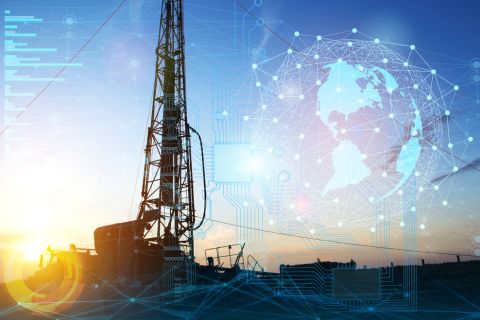
Statoil has installed new 24-hour methane emissions detection technology at a production facility in the Eagle Ford. Pictured are Desikan Sundararajan (left) and Andrea Machado Miguens, senior researchers for Statoil, and Quanta3 Founder Dirk Richter (center). (Source: Environmental Defense Fund)
When technology brings together an environmental group and an oil and gas company, what happens next could be transformative.
At least that is what Statoil ASA (NYSE: STO), the Environmental Defense Fund (EDF) and Quanta3, a Colorado-based technology startup, hope will happen in the area of methane emissions detection in oil and gas fields.
Statoil is field testing new methane leak-detecting technology, which uses laser-based sensors developed by Quanta 3, at one of its Eagle Ford Shale production facilities.
The test is part of the Methane Detectors Challenge, the partnership in which EDF is working alongside oil, gas and technology companies, among others, in an effort to detect and fix leaks faster. Such moves could prove useful in not only lowering emissions and improving air quality, but they could also play a role in recapturing natural gas and producing profit for energy companies.
“This initiative can be a step-change in how the shale oil and gas industry will monitor fugitive emissions in the future,” Andrea Machado, senior researcher in Statoil’s shale oil and gas R&D team, said in a statement about the challenge. “Implementing continuous methane detection can reduce loss of valuable product and ensure a cleaner environment.”
But it’s too early to tell whether the technology, which uses tunable laser diodes as sensors, is paying off.
The solar-powered technology, which continuously monitors and detects methane leaks, was installed in early January and initial results are expected in about three to four weeks, Aileen Nowlan, manager of the Methane Detectors Challenge, told Hart Energy.
The system, which is connected to a cloud network, detects methane in the air and factors in data, such as weather, when sending an alert to the operator. Although the technology is tuned only to methane, the presence of methane could indicate the possibility that other volatile organic compounds are also being release, Nowlan said, adding “data analysis is just as important as the concentration reading.”
Dirk Richter, founder and CEO of Quanta3, said he was inspired after learning of the challenge to put his knowledge of laser-based systems to work toward developing the 24-hour monitoring technology.
The technology was specifically created as part of the challenge.
“We believe oil and gas production should be leak-free,” Richter said in a statement about the field test.
The work is being carried out as many across the world step up efforts to combat greenhouse gas emissions.
In May 2016, the U.S. Environmental Protection Agency (EPA) released its first standards targeting methane emissions—the second highest greenhouse gas emitted from human activity in the U.S.—from oil and gas sites. Methane trails only CO2. The regulation requires owners or operators of new or modified oil and gas well sites to develop and implement leak monitoring plans and use optical gas imaging to conduct leak surveys. All leaks must be repaired.
RELATED: New Rules: US Targets Methane Emissions From Oil, Gas Wells
The oil and gas industry has made strides in past decades in lowering emissions. By American Petroleum Institute (API) estimates, U.S. carbon emissions are near 20-year lows. Many experts credit coal-to-gas switching for electric power generation for the reduction in methane.
The API has also pointed to EPA statistics showing that methane emissions associated with the natural gas sector dropped by 14.8% between 1990 and 2014—even as natural gas production rose by 47%.
However, some companies in the industry are missing an opportunity.
“Globally, the oil and gas industry loses about $30 billion of natural gas a year from leaks at dispersed sites ($2 billion in the U.S.), much of it from unintentional leaks that can be difficult to detect without continuous monitoring,” the EDF said. “Studies show that natural gas leaks can be reduced at least 40% at an average cost of about one penny per thousand cubic feet of gas produced, which will not affect low electricity or gasoline prices for the consumer.”
The EDF, among others, is optimistic that technology will lead to further improvement.
“By building bridges between innovators and companies that want scalable solutions, EDF is accelerating technologies that can help the oil and gas industry reduce waste and forging solutions that improve efficiencies, build safer communities and let the planet thrive,” Nowlan said in the statement.
Statoil’s participation in the challenge is just one way it is working to be a more “carbon efficient oil and gas producer.”
The company is also using infrared technology in the Eagle Ford to find emissions. The technology enables reductions of between 10% and 90% while also improving air quality, Statoil said.
Velda Addison can be reached at vaddison@hartenergy.com.
Recommended Reading
Well Logging Could Get a Makeover
2024-02-27 - Aramco’s KASHF robot, expected to deploy in 2025, will be able to operate in both vertical and horizontal segments of wellbores.
TotalEnergies Starts Production at Akpo West Offshore Nigeria
2024-02-07 - Subsea tieback expected to add 14,000 bbl/d of condensate by mid-year, and up to 4 MMcm/d of gas by 2028.
Shell Brings Deepwater Rydberg Subsea Tieback Onstream
2024-02-23 - The two-well Gulf of Mexico development will send 16,000 boe/d at peak rates to the Appomattox production semisubmersible.
E&P Highlights: Feb. 26, 2024
2024-02-26 - Here’s a roundup of the latest E&P headlines, including interest in some projects changing hands and new contract awards.
Remotely Controlled Well Completion Carried Out at SNEPCo’s Bonga Field
2024-02-27 - Optime Subsea, which supplied the operation’s remotely operated controls system, says its technology reduces equipment from transportation lists and reduces operation time.






